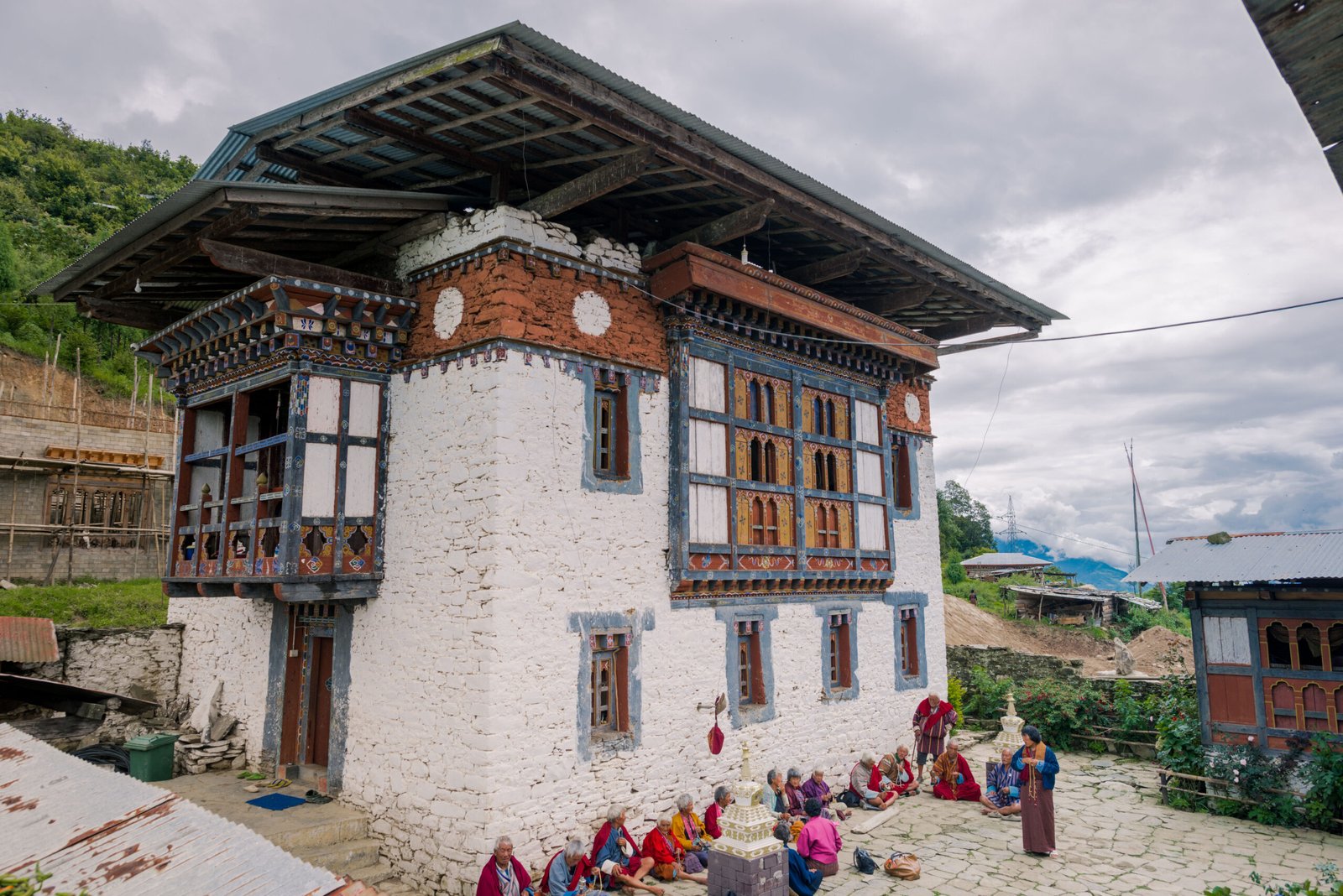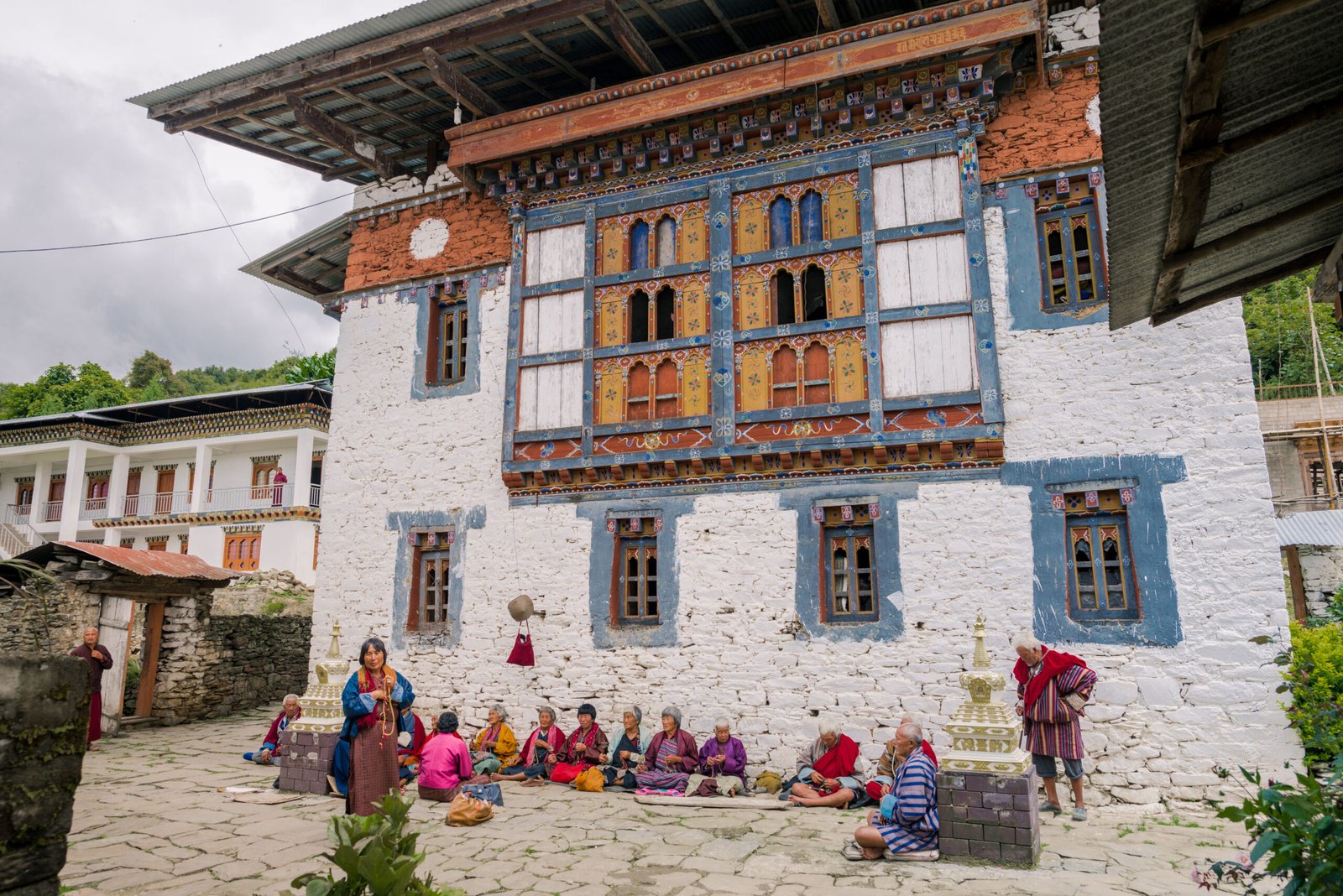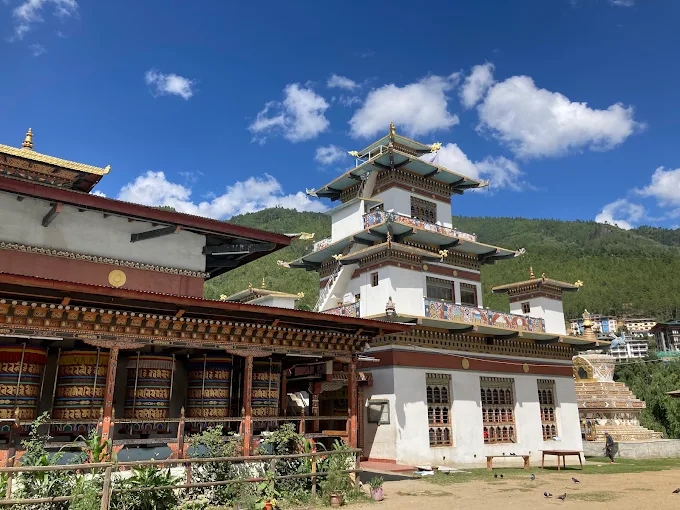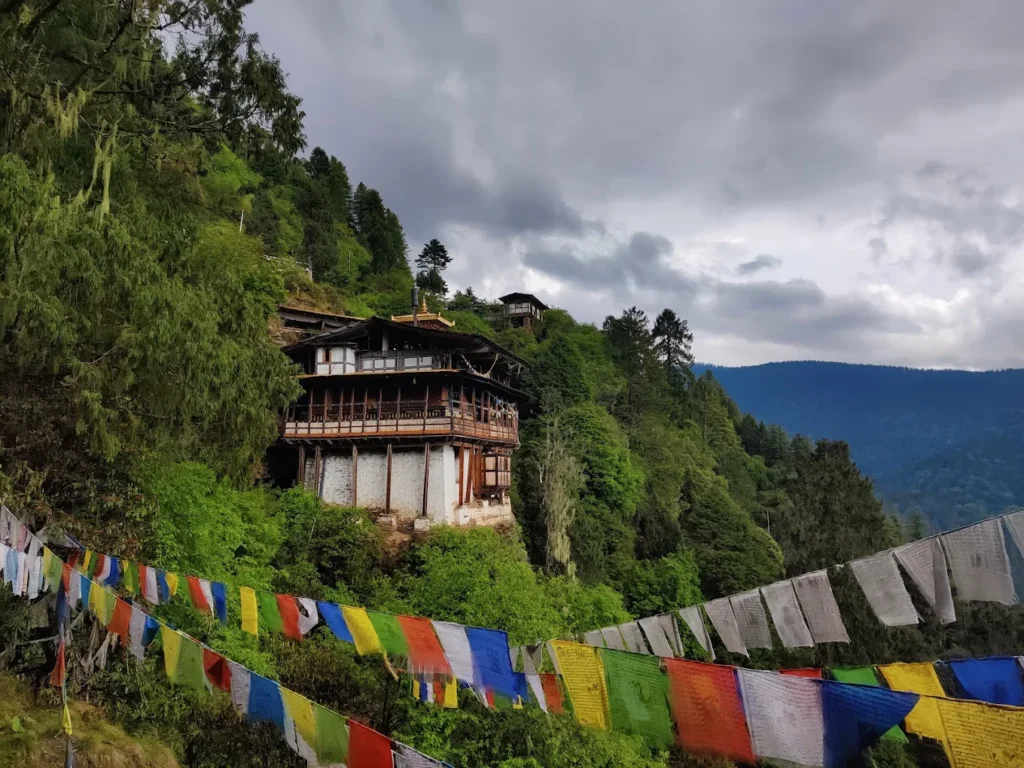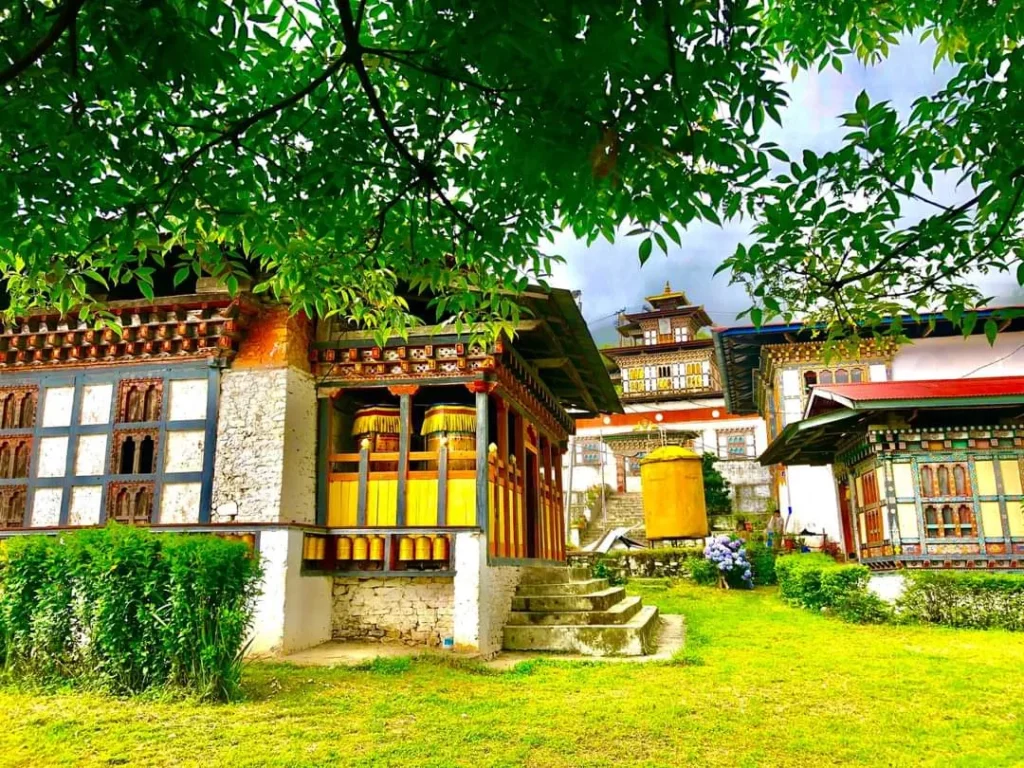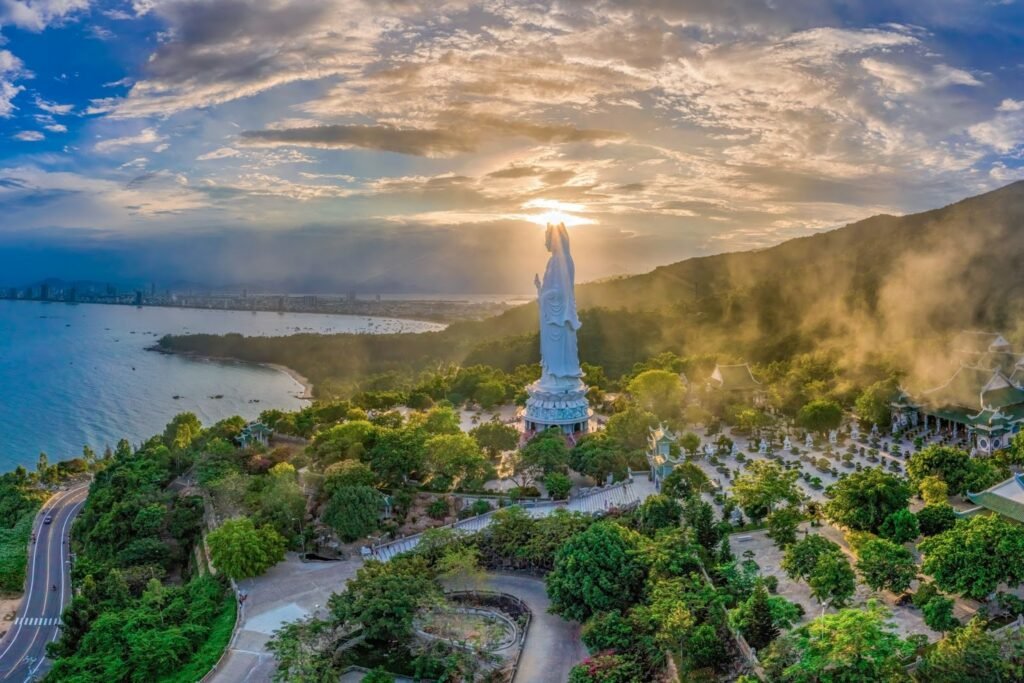Sangchen Ogyen Tsuklag Monastery: Sacred Canvas of Trongsa’s Nyingma Legacy
As twilight settles over Trongsa’s Samcholing village, Sangchen Ogyen Tsuklag Monastery hums with quiet reverence, its two-story temple nestled against Bhutan’s rugged hills. Candlelight flickers across an 8th-century wall painting of Zhitro Lhatsog, a mandala of deities glowing with ancient hues, while monks’ chants echo the Longchen Nyingthik teachings. Before a spoken Buddha statue, devotees offer butter lamps, their flames dancing with prayers to Guru Rinpoche (Padmasambhava), the tantric master who blessed this land. During the Tshechu festival, masked dancers swirl in the courtyard, honoring Bhutan’s Nyingma heritage. Founded in the 8th century by Khandro Tashi Khyidren, Guru Rinpoche’s Bhutanese consort, and renamed in 2009 by Khedrupchen Rinpoche, this monastery carries an unbroken lineage from Padmasambhava. Tucked in Trongsa’s serene valley, it weaves meditation, art, and history, inviting seekers to a sanctuary where Bhutan’s spiritual pulse thrives.
Overview and Significance
Sangchen Ogyen Tsuklag Monastery, cradled in Samcholing village, Trongsa, stands as a Nyingma beacon, its Zhitro Lhatsog painting a sacred thread to Bhutan’s 8th-century origins. This haven of meditation and ritual unveils a legacy of devotion and cultural pride.
Introduction to Sangchen Ogyen Tsuklag Monastery
Sangchen Ogyen Tsuklag Monastery, once Rephel Mindrol Lhakhang, rises in Trongsa’s tranquil hills, a testament to Nyingma Buddhism’s heart essence teachings. Nyingma, Bhutan’s oldest Buddhist school, emphasizes meditation and the Longchen Nyingthik lineage, a path to enlightenment revealed by Padmasambhava. Founded in the 8th century by Khandro Tashi Khyidren, the monastery was revitalized in 2009 by Khedrupchen Rinpoche, who renamed it to honor its sacred roots. Its 8th-century wall painting, a mandala of deities, marks it as a cultural treasure, drawing pilgrims to a site where history and faith converge.
Historical Journey
The monastery’s past unfolds across centuries:
- Founding (8th Century): Khandro Tashi Khyidren, Guru Rinpoche’s consort, built her retreat here, blessing the site with holy water and relics.
- Later Masters: It became a seat for figures like Rephel Lama Gyeltsen and Yabje Tenpai Nima, father of Zhabdrung Ngawang Namgyel.
- Renaming (2009): Khedrupchen Rinpoche took stewardship, renaming it Sangchen Ogyen Tsuklag.
- Restoration: Reconstruction began in 2016 to preserve its ancient walls and expand facilities.
Cultural Significance
The monastery shapes Bhutan’s spiritual fabric:
- Nyingma Hub: It transmits Longchen Nyingthik teachings, guiding meditation.
- Community Core: Tshechu festivals unite Samcholing residents.
- Historical Relic: The Zhitro Lhatsog painting preserves 8th-century art.
Unique Legacy
The 8th-century wall painting and spoken Buddha statue define the monastery’s sacred identity.
Community and Global Impact
- Local Role: Hosts education and rituals for Samcholing’s residents.
- Diaspora Draw: Attracts Bhutanese Buddhists worldwide.
- Global Vision: Khedrupchen Rinpoche’s teachings reach international seekers.
Historical Anecdotes
- Khandro Tashi Khyidren meditated here, leaving a horse’s hoofprint relic.
- In 2009, locals offered the monastery to Khedrupchen Rinpoche, reviving its legacy.
Social Role
Drubchen ceremonies and charity strengthen community ties.
Artistic Influence
The Zhitro Lhatsog painting inspires Bhutanese thangka artists.
The monastery’s history shapes its form, where ancient walls and sacred relics frame a space of devotion.
Architectural and Spiritual Features
Sangchen Ogyen Tsuklag’s two-story temple blends Nyingma simplicity with Bhutanese artistry, its Zhitro Lhatsog painting a vivid link to the 8th century. This section unveils its design and sacred treasures.
Iconic Design
The temple’s wooden beams and whitewashed walls rise beneath Trongsa’s hills, its sloped roof adorned with golden finials. A courtyard of packed earth hosts dances, framed by prayer flags fluttering in the mountain breeze.
Key Structures
- Main Temple (Lhakhang): A two-story hall with fading wall paintings and wooden altars.
- Monks’ Hostel: A modest 2017 structure housing 40 monks.
- Courtyard: A space for Tshechu dances and rituals.
- Relic Site: A spring 15 meters away, revealed by Guru Rinpoche.
Worshipped Statues/Deities
- Spoken Buddha Statue: A sacred icon, believed to have spoken, crafted by Trulku Chogden Gompo.
- Guru Rinpoche: A statue honoring Padmasambhava’s legacy.
Materials and Techniques
Timber beams and stone walls, with hand-painted murals, reflect Bhutanese craft.
Signature Elements
The Zhitro Lhatsog painting and spoken Buddha statue anchor the temple’s sanctity.
Lesser-Known Features
- Horse Hoofprint: A rock behind the temple bears Khandro Tashi Khyidren’s relic.
- Treasure Bell: Terton Sherab Mebar’s bell rests in the altar.
Preservation Efforts
Since 2016, Khedrupchen Rinpoche’s restoration protects fading murals.
Environmental Integration
The temple nestles into Trongsa’s hills, its spring a sacred link to nature.
Artisan Narratives
Local painters retouched murals, preserving 8th-century techniques.
Symbolic Details
Zhitro deities symbolize enlightenment; lotus motifs reflect purity.
Landscape Integration
The temple’s hilltop perch offers views of Trongsa’s valleys, enhancing its sanctity.
These spaces frame the monastery’s rituals, inviting devotees into its meditative pulse.
Rituals and Practices
Sangchen Ogyen Tsuklag’s rituals, rooted in Nyingma’s Longchen Nyingthik lineage, blend meditation and ceremony, fostering enlightenment. This section explores its spiritual practices.
Daily Sacred Rites
- Sutra Chanting: Monks recite Nyingma texts at dawn.
- Offerings: Butter lamps and incense honor Guru Rinpoche.
- Meditation: Sessions focus on Dzogchen visualization.
Unique Practices
During Drubchen, monks craft torma sculptures, offerings unique to Nyingma rites.
Festival Traditions
- Tshechu: Masked dances in October honor Guru Rinpoche.
- Drubchen: Week-long rituals pray for sentient beings’ welfare.
Visitor Engagement
Guests may join meditation or observe Tshechu dances, guided by monks.
Spiritual Community Roles
Monks lead rites; locals support festivals, fostering unity.
Interfaith Connections
Occasional exchanges with Drukpa Kagyu monks reflect Bhutanese harmony.
Ritual Symbolism
- Torma: Sculptures symbolize impermanence.
- Prayer Flags: Colors represent elemental balance.
Seasonal Variations
Tshechu intensifies in autumn; Losar adds New Year prayers.
Monastic/Community Life
Monks study Dzogchen; locals tend the courtyard.
These rituals guide visitors to the monastery’s philosophical depths.
Visitor Information
Sangchen Ogyen Tsuklag welcomes travelers to Trongsa’s hills, offering practical details to engage with its spiritual heart.
Navigating to Sangchen Ogyen Tsuklag Monastery
In Samcholing village, a 1.5-hour drive from Trongsa town, the monastery lies a 10-minute walk from Samcholing Middle Secondary School, marked by prayer flags.
Address of Sangchen Ogyen Tsuklag Monastery
Samcholing, Trongsa County, Bhutan
Visiting Hours and Etiquette
- Hours: Open daily from 7:00 AM to 5:00 PM, extended during Tshechu.
- Etiquette: Dress modestly; remove shoes in the temple; avoid photographing altars.
Transport Options
- Car: A 1.5-hour drive from Trongsa via hired taxi.
- Bus: Trongsa buses stop at Samcholing School, then a short walk.
- Trekking: A 30-minute hike from Samcholing village.
Accessibility and Safety
- Accessibility: The courtyard is flat; the temple has steps.
- Safety: Trongsa is safe, but carry water for the walk.
Amenities and Surroundings
Basic restrooms; nearby Samcholing village offers tea stalls.
Immersive Tips
Visit in October for Tshechu dances or join morning meditation.
Nearby Cultural Experiences
- Trongsa Dzong: 1.5 hours away, a historic fortress.
- Burning Lake: A 2-hour drive, a sacred site.
Photography Tips
Capture the stupa at sunrise; respect altar restrictions.
The monastery’s gates open to its Nyingma philosophy, where teachings and stories unfold.
Cultural and Spiritual Insights
Sangchen Ogyen Tsuklag’s essence lies in its Nyingma roots and resilient community, offering insights into Bhutan’s spiritual depth.
Religious Philosophy
Nyingma’s Longchen Nyingthik teaches enlightenment through meditation, guiding devotees to innate wisdom.
Environmental Spirituality
The sacred spring reflects nature’s sanctity, a Nyingma tenet.
Artistic Symbolism
Zhitro deities symbolize liberation; lotus motifs signify purity.
Community Resilience
In 2009, locals revived the monastery, a testament to devotion.
Environmental Stewardship
Monks plant trees annually, honoring Bhutan’s eco-ethos.
Meditative Practices
Dzogchen sessions cultivate inner clarity, open to visitors.
Cultural Narratives
Khandro Tashi Khyidren’s legacy inspires Tshechu tales.
Historical Context
The monastery ties to Bhutan’s 8th-century Buddhist spread.
These insights weave a reflection on the monastery’s enduring presence.
Conclusion
Sangchen Ogyen Tsuklag Monastery stands as a guardian of Trongsa’s Nyingma heritage, its Zhitro Lhatsog painting a vivid link to Khandro Tashi Khyidren’s 8th-century vision. Guru Rinpoche’s spoken statue and Tshechu’s masked dances pulse with Longchen Nyingthik wisdom, weaving meditation into Bhutan’s hills. From Samcholing’s courtyard to the temple’s ancient walls, it offers solace where devotion meets history. As a living relic, it bridges Bhutan’s past and present, inviting travelers to pause beneath its prayer flags, where faith and art whisper of timeless enlightenment.
